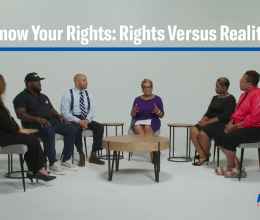In 1998, the Ohio State Penitentiary, also known as the “Supermax,” opened as the only super-maximum security prison in Ohio. Meant to hold those prisoners deemed most dangerous, the Supermax had restrictive and harsh conditions. Inmates spent twenty-three hours a day in solitary cells, had no opportunities for outdoor recreation, and lacked adequate medical and mental health care. In addition, the Ohio Department of Rehabilitation and Correction (ODRC) used procedures for assigning inmates to the Supermax that led many prisoners, including those with mental illness, to be transferred to the Supermax without notice or explanation.
ACLU of Ohio lawyers Staughton Lynd, Alice Lynd, Ray Vasvari, Mike Benza, and Jillian Davis worked with attorneys from the Center for Constitutional Rights (CCR), particularly Jules Lobel, to file a lawsuit against officials of the ODRC on behalf of Charles Austin and other Supermax prisoners. The ACLU of Ohio and CCR argued that the conditions at the prison amounted to cruel and unusual punishment and violated inmates’ Eighth and Fourteenth Amendment rights. Before the trial began, the ACLU of Ohio and CCR came to a settlement with ODRC officials to improve medical and mental health oversight, construct an outdoor exercise area, and limit the use of excessive restraints within the prison. However, issues remained over how officials classified prisoners and determined whom to transfer to the Supermax. In 2002, the U.S. District Court judge ruled in favor of the inmates, declaring that they had a liberty interest in not being sent to the Supermax and that the system for assigning inmates to the Supermax violated due process under the Fourteenth Amendment. The judge ordered ODRC officials to adopt new procedures.
The state appealed the U.S. District Court’s decision. On June 10, 2004, the U.S. Sixth Circuit Court of Appeals agreed that “confinement at the Supermax prison is an atypical and significant hardship” and approved procedural changes but reversed substantive changes to the regulations. The state appealed again. On June 13, 2005, the U.S. Supreme Court ruled that prisoners have a liberty interest in avoiding assignment to the Supermax because of its harsh conditions and loss of parole eligibility. The court concluded that the placement scheme developed during litigation, which included giving inmates notice of transfer and a chance for rebuttal at a hearing, satisfied prisoners’ due process rights. However, it took until 2008 before Ohio’s policies and procedures were found by the District Court to be no longer in violation of prisoners’ constitutional rights.
Read the U.S. District Court’s decision (February 25, 2002) and order (March 26, 2002) in Austin v. Wilkinson.
Read the U. S. Sixth Circuit Court of Appeals’ decision.
Read the U.S. Supreme Court’s decision.
Read the ACLU of Ohio’s summary of the case in the Spring 2002 issue of its newsletter.
Read the ACLU of Ohio’s summary of the legal victory in the Fall 2005 issue of its newsletter.









